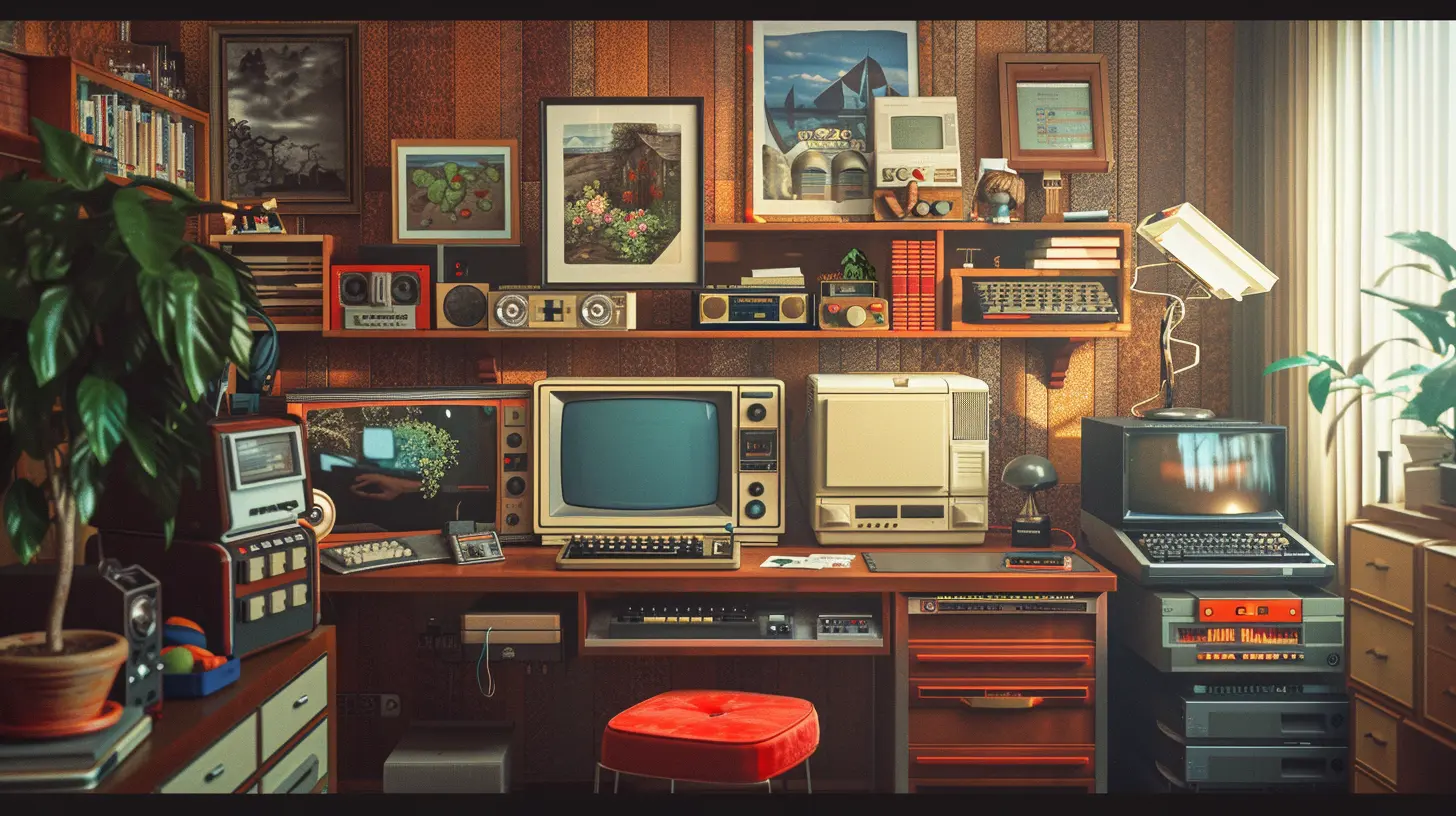How Early Game Developers Pushed the Limits of Technology
16 May 2025
When you sit down to play your favorite games today that are filled with jaw-dropping graphics, lifelike physics, and expansive open worlds, do you ever stop to think about where it all began? It’s easy to take for granted the insane technological leaps that brought us to this point. But in the early days of gaming, things were... well, a bit scrappier. The pioneers of game development were like DIY tinkerers in a garage, MacGyvering their way into making things work. These trailblazers didn’t just program games—they bent the very fabric of technology to make the impossible possible.
So, how did they do it? Grab your favorite snack, get comfy, and let’s dive into the story of how early game developers rewrote the rules of what technology could do.
The Humble Beginnings: Pong and Pixelated Dreams
Let’s rewind to the 1970s—the digital stone age of gaming. Back then, the concept of video games was so new, people thought it was some kind of glitchy TV. Enter Pong, the grandparent of games. Created by Atari and released in 1972, Pong was literally just two paddles and a square "ball". Simple, right? But even creating something this basic was revolutionary at the time.Hardware was laughably limited: processors had the computing power of a potato (OK, not literally). Developers didn’t have complex game engines or fancy 4K rendering—they were coding directly onto hardware with tiny amounts of memory. Everything, from collision detection to the movement of that pixelated ball, had to be meticulously hand-crafted with next to no resources.
Think about it like trying to write a novel and only being allowed to use 100 words. The ingenuity and creativity it took to pull off Pong and other early games laid the foundation for everything that came after.
Pushing Pixels (Because That’s All They Had)
Fast forward a few years, and developers started doing something bold: making games look better. This was the era of 8-bit graphics, when every pixel felt like a tiny miracle. But here’s the catch: the hardware still hadn’t quite caught up to these big ambitions.Take Space Invaders (1978) as an example. This game introduced moving sprites (the alien invaders) and a bit of sound. For its time, it was cutting-edge—like the iPhone of arcade games. But the developers had to hack their way around hardware constraints. Fun fact: the reason the aliens move faster as you shoot them? It wasn’t an intentional design choice—it happened because there was less stuff on the screen for the processor to handle. What started as a technical quirk became a feature we all loved.
Developers were magicians, coaxing every last drop of performance from their limited systems. They learned to “fake it ‘til they made it.” Shadows? Oh, that’s just reused pixels in darker colors. Depth? Just layered 2D sprites. It was like trying to paint a masterpiece on a postage stamp.
The 3D Leap: Doom, Quake, and the Birth of Virtual Worlds
And then, the 90s arrived, and boy, things got serious. This was the decade of 3D gaming, where developers attempted to trick our brains into believing that flat screens had depth. Spoiler alert: they nailed it.John Carmack, co-creator of Doom (1993) and Quake (1996), deserves his own superhero title. This guy basically invented the blueprint for modern 3D gaming. The hardware of the time? Still laughably weak. But Carmack and his team wrote custom game engines that made it look like you were running around in a 3D world, even though it wasn’t “true” 3D. It was all smoke and mirrors—ingenious use of algorithms, lighting tricks, and something called “binary space partitioning” (don’t worry, no math test at the end of this).
Doom wasn’t just a cool game; it was a revolution. It introduced modding—players could create their own levels—and proved that gaming could be more than a fun pastime. It could be a creative outlet and even an art form.
Sound and Music: Composers With a Techie Twist
We can’t talk about early gaming without giving a shoutout to the soundtracks. You know that catchy Mario theme song that’s probably playing in your head right now? Yeah, that’s the work of Koji Kondo, a mad genius who turned a Nintendo sound chip into his personal orchestra.Back in the day, music for games wasn’t just composed—it was programmed. Developers couldn’t just slap an MP3 onto a game (MP3 didn’t even exist yet!). Instead, sound was crafted using basic waveforms generated by the hardware. It’s like writing music with a calculator.
But despite the limitations, these early soundtracks slapped. From the eerie bleeps of Metroid to the adrenaline-pumping tunes in Mega Man, developers and composers worked hand-in-hand to push the boundaries of sound technology. And let’s be honest, they created some of the most iconic gaming earworms in history.
Easter Eggs and Secrets: When Developers Got Playful
Here’s a fun detour: did you know early game developers were also jokesters? Since games were programmed line by line, it wasn’t uncommon for developers to sneak in little surprises, known as Easter eggs.One famous example is Adventure (1980), a game for the Atari 2600. The creator, Warren Robinett, hid a secret room with the text “Created by Warren Robinett.” Why? Because back then, developers didn’t get credit for their work! Imagine making a blockbuster game and not even getting your name in the credits. If I were Warren, I’d probably do the same thing.
These Easter eggs were just another way for developers to have fun with technology, even if they were working under tight constraints. It’s like drawing a smiley face on the back of a masterpiece—just because you can.
Multiplayer Magic: From Arcade Cabinets to LAN Parties
Remember when multiplayer gaming meant two players huddled around the same screen, taking turns or sharing controllers? Early developers weren’t satisfied with that. They dreamed of connecting players—even if it meant rewriting entire systems.Street Fighter II (1991) deserves a medal for kickstarting competitive gaming. It wasn’t just about beating up your buddy—it was about timing, skill, and showing off. But arcade cabinets were limited, so developers had to engineer everything to be ultra-responsive, ensuring every button press felt instantaneous.
Then came LAN gaming, where multiplayer games like Doom and Quake connected players through local networks. Setting up a LAN party involved more wires than a conspiracy theorist’s corkboard, but when you finally fragged your friend across the room? Absolutely worth it. Developers were now building games with connectivity in mind, paving the way for the online multiplayer behemoths we enjoy today.
Lessons From the Pioneers
Looking back, it’s clear early game developers weren’t just programmers—they were dreamers, hackers, and borderline wizards. They had a vision for what gaming could be and didn’t let technology’s boundaries stop them. In fact, they redefined those boundaries.If there’s one takeaway from their story, it’s this: constraints breed creativity. The next time you’re playing a visually stunning game like The Legend of Zelda: Tears of the Kingdom or an expansive epic like Starfield, take a moment to appreciate the scrappy brilliance of the developers who paved the way. Without their ingenuity, gaming wouldn’t be the incredible medium it is today.
Wrapping It All Up
So there you have it—the tale of how early game developers pushed technology to its breaking point and created magic in the process. They didn’t have AI, ray tracing, or terabytes of storage, but they had something even better: imagination and determination. The next time you boot up your favorite game, give a silent nod to these trailblazers. They deserve it.all images in this post were generated using AI tools
Category:
Gaming HistoryAuthor:

Brianna Reyes
Discussion
rate this article
3 comments
Eleanor McGowan
Fascinating how early developers defied tech boundaries! What innovations surprised you the most?
May 28, 2025 at 4:18 AM

Brianna Reyes
Thank you! I was especially surprised by the creative use of limited hardware, like how developers utilized memory management techniques to create expansive game worlds despite strict limitations.
Ryan Wyatt
Early game developers were basically the MacGyvers of tech—turning cereal boxes into consoles and coding with nothing but pure caffeine and sheer determination. Who knew pixels had such a rich history?
May 24, 2025 at 3:49 PM

Brianna Reyes
Absolutely! Early game developers truly embodied creativity and resourcefulness, transforming simple materials into groundbreaking technology and paving the way for the gaming industry we know today.
Holden Warren
Inspiring innovation, shaping gaming.
May 16, 2025 at 2:57 AM

Brianna Reyes
Thank you! Early game developers truly revolutionized technology and creativity, paving the way for the industry we know today.



